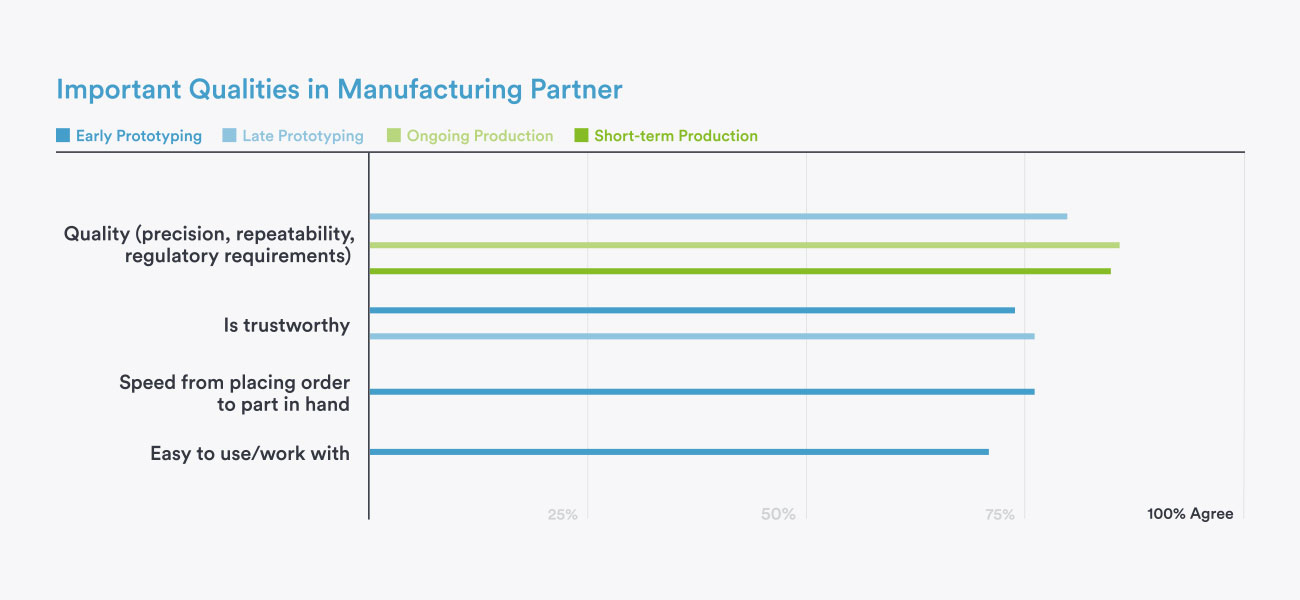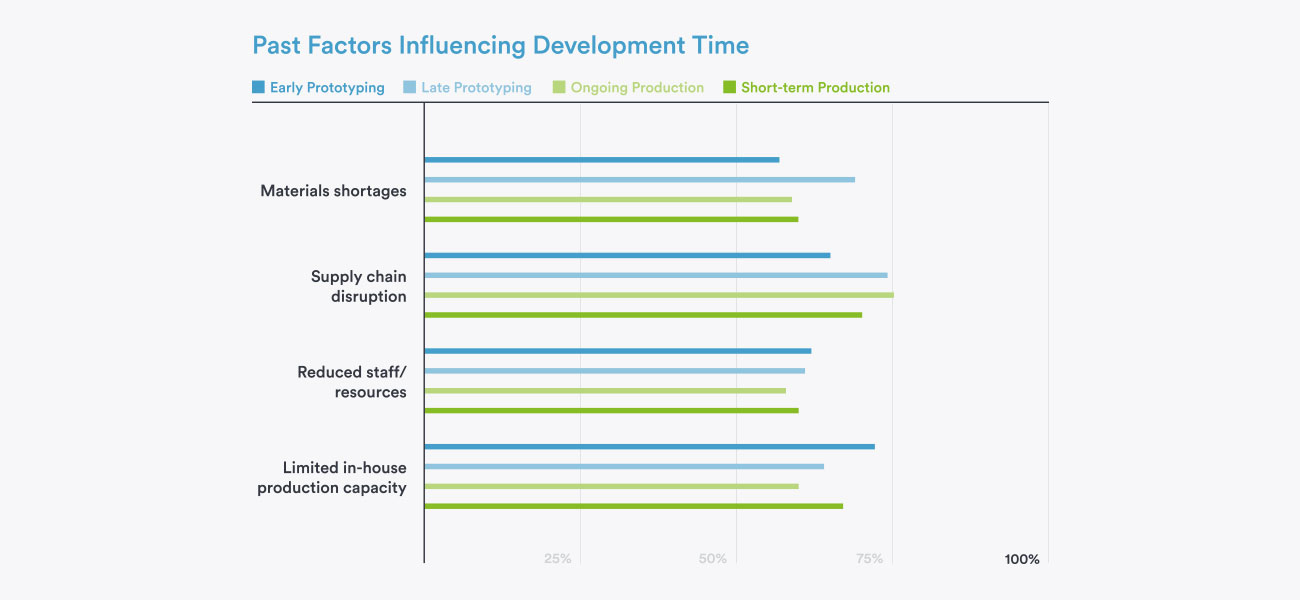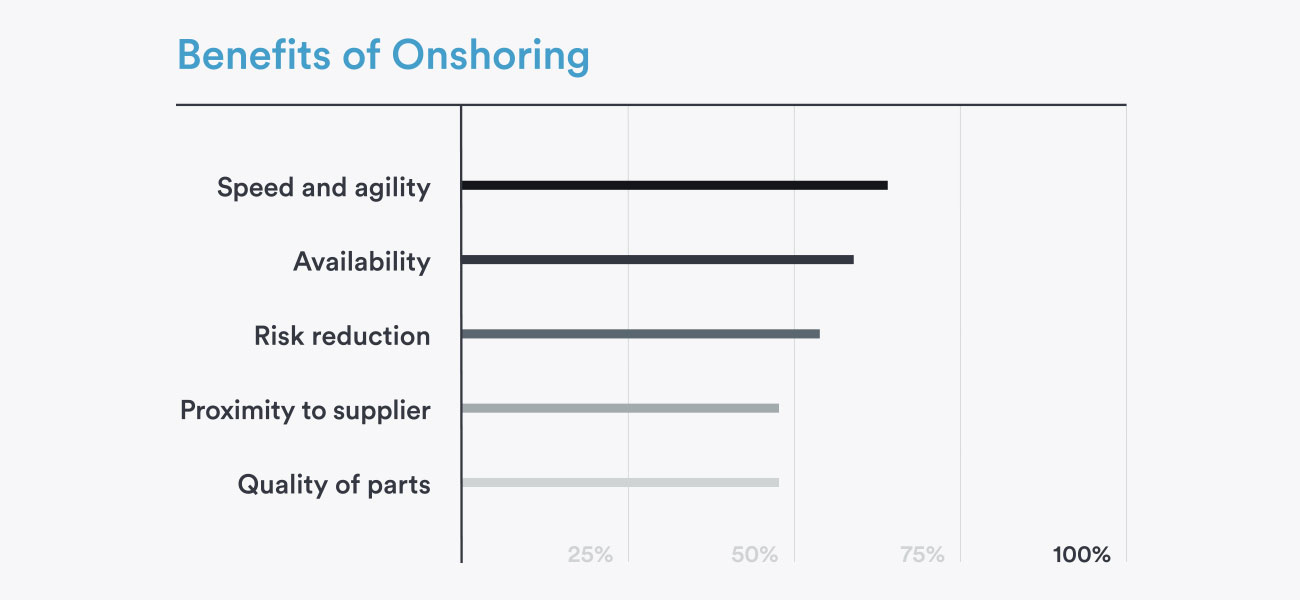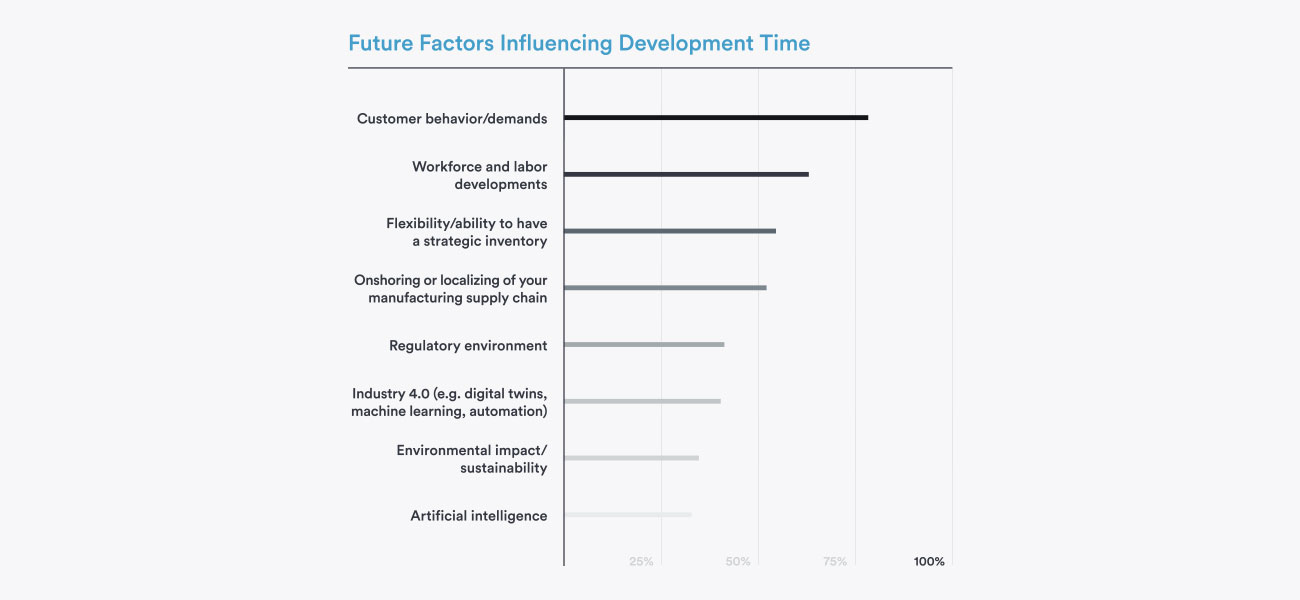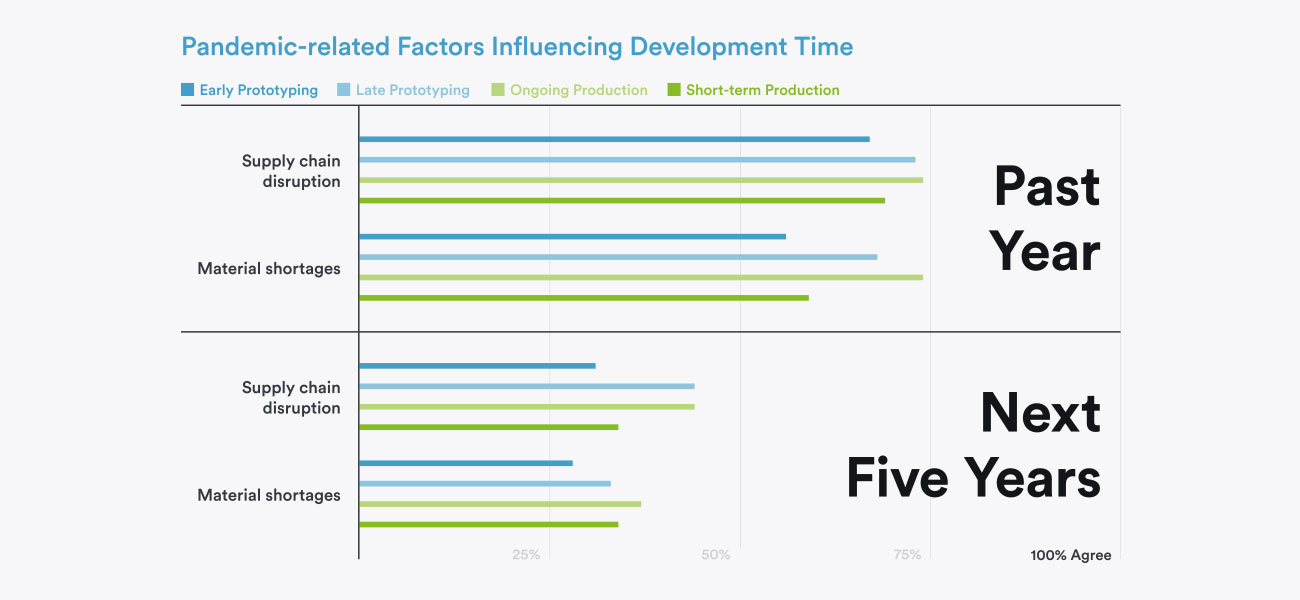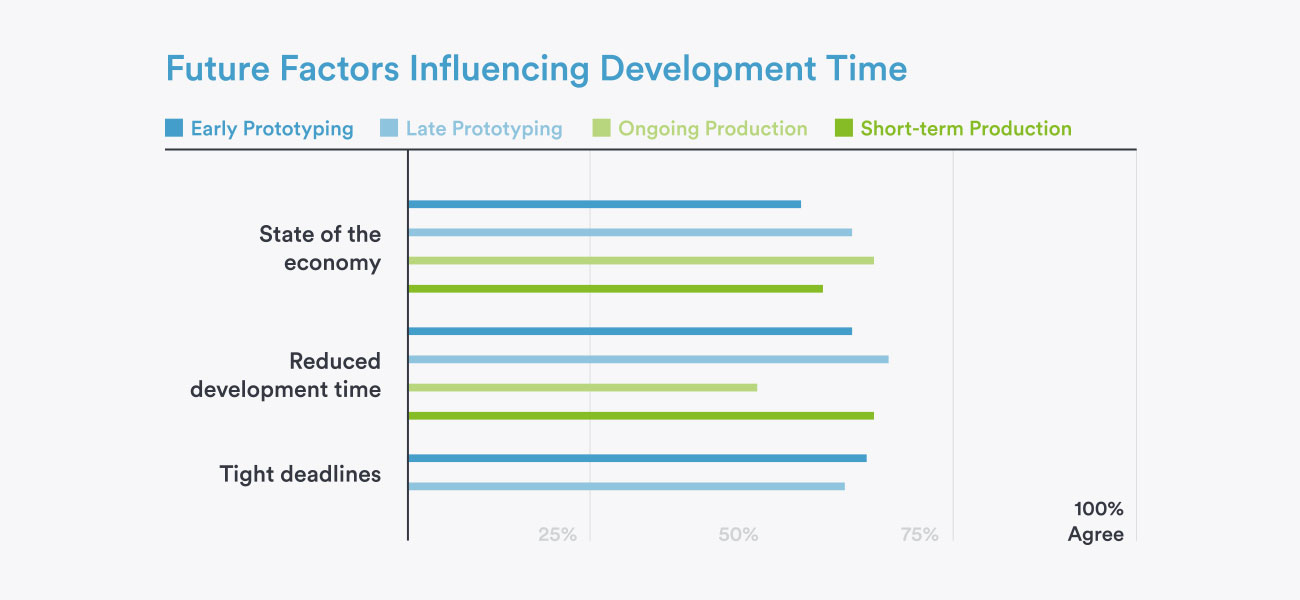Product Development Trends in 2024
Innovation leaders share the factors shaping how we bring products to market today and in the future.
Executive Summary
What does the future hold for product development?
At Protolabs, we wanted to gain an understanding of the issues and challenges product developers have faced recently and those they are expecting to confront in the near future. So, this past fall our market research team surveyed more than 700 engineers, designers, and product developers from industries on the frontline of innovation. These include aerospace, automotive, and other industries we serve.
The survey results suggest that product development is at a potential inflection point as engineers and designers take on evolving challenges.
First, those surveyed told us that their top product development challenge is the element of time. No matter what stage of development they’re in, there never seems to be enough time for prototyping, for launching a product to market, and even for ongoing production. The takeaway? The amount of time (or, more accurately, the lack of time) and the related urgent need for speed are the biggest product development barriers to success as products move to production, a criticial obstacle for companies to overcome.
Second, for the most part they are feeling optimistic about the years ahead, especially about potentially moving beyond pandemic-caused challenges such as supply chain disruptions and material shortages. Despite this, they acknowledge those pandemic headwinds persisted somewhat over the last year and continued to affect product development. Also, they recognized that other factors are expected to have a larger impact moving forward, particularly the state of the economy and workforce development.
Finally, they weighed in briefly on the future, giving us their opinions on how matters such as artificial intelligence (AI), sustainability, and shifting economic forces each play a role in product development.
Takeaway
This report is split into sections that:
- Define the current state of product development.
- Investigate the factors that have shaped product development to date.
- Elaborate on the influences shaping product development during the next five years.
Defining Product Development
As a digital manufacturer, we work with more than 50,000 developers annually to accelerate the product development process for the custom parts we produce for them. We use a range of manufacturing methods at our factories in the U.S. and beyond to build custom parts for our customers, and also provide a manufacturing network to connect our customers to additional production services. So, let’s start with how we define product development. We work with customers from the earliest stage of prototyping through market launch and ongoing production to help them iterate faster and scale up production in response to demand.
Taking this holistic view, in a poll we conducted in the fourth quarter of 2023, we surveyed 767 engineers and designers— from companies of all sizes, and from a variety of industries—for a deeper dive into product development. Our goal was to examine the forces that have shaped product development as it stands today, and to take the pulse of the innovators
who are bringing products to market as we move through the new year and beyond.
First, the good news.
One side of the coin shows that the challenges product developers have been facing, such as limited in-house capacity, supply chain disruption, and material shortages— factors most closely related to the pandemic—are expected to decline.
On the flip side, the challenging news is that the state of the economy, workforce development, and increasing consumer demand will continue to test most industries.
Our survey asked questions centered around four prototyping and production stages for custom parts.
- Early Prototyping: Developing custom parts used to iterate early design in cases such as concept models, and in assessing form, fit, or functionality.
- Late Prototyping: Perfecting custom parts used later in the product development process, for example in pilot runs and market testing.
- Ongoing Production: Working with end-use production parts used during the normal course of a product’s life cycle.
- Short-term Production: Maintaining inventory of end-use parts used during a product’s early growth and late maturity phases.
The Current State of Product Development
Timeline
On average, the product development journey takes about two years (22 months). Our survey findings show that products typically spend the following amount of time in each stage, with ongoing production needs being the longest phase at nearly a year, and the other three roughly equal at 3–4 months each.
Budget
Beyond a development “timeline,” as a contract manufacturer we also wondered about companies that budget for outsourced manufacturing. That is, we were curious what percentage of a budget is set aside for manufacturing outsourcing during each of these development stages. The results indicated that budgeting for outsourcing happens equally in all stages except short-term production, which accounts for half the amount of each of the other three.
Engineer for manufacturer of industrial sealing products
Ongoing Challenges
We know product developers navigate multiple—and often ongoing—challenges along the way in developing products. We wanted to dive in and learn more about these challenges.
Notably, those surveyed identified time as a prime challenge across all development changes, from early prototyping through production. Indeed, fewer survey respondents mentioned that even cost considerations were a main issue across all stages. This challenge was mentioned frequently in the open-ended comments section of the survey, and mentioned in multiple ways: “timeline,” “lead time,” “turnaround time,” “timeliness,” “time constraints,” “time crunch,” and more.
Other factors influencing product development that were identified in the survey included cost, quality, and making changes/adjustments.
Takeaway
The amount of time and the related urgent need for speed are the biggest product development barriers to success across all stages, from prototyping through production.
Along these lines, more than half of the respondents say they are developing products faster than ever—82% are constantly looking for ways to speed up development and 65% expressed the need to develop products faster to stay ahead of the competition.
Choosing a Manufacturing Partner
Now that we know the primary challenges, what are product developers prioritizing when choosing a manufacturing partner? The answer depends on the stage of product development. As expected, speed is the top priority during early prototyping, but trustworthiness and ease-of-use follow close behind.
Once development moves to later prototyping, quality jumps to the top, barely beating out trustworthiness. Finally, quality rules over all during ongoing and short-term production with 86% and 85% of survey respondents putting it at the top in those respective stages.
Medical Device Designer
Pandemic Headwinds Shaped Development
What market and economic forces have influenced product development over the last year or so?
Material shortages, supply chain disruption, reduced resources/staff, and limited in-house production capacity all affected product development over the past year, according to survey respondents. Not surprisingly, all of these issues can be traced back to pandemic-induced challenges, which persisted in 2023. Furthermore, product developers encountered all of these concerns at every stop along a product’s development journey.
Engineer for Laser Designer/Manufacturer
Takeaway
The pandemic continued to influence product development. Though actual COVID-19 case numbers are down significantly in the U.S., pandemic-induced obstacles persisted for product developers, including material shortages, supply chain disruptions, reduced staff/resources, and limited in-house production capacity.
Consumer demand and competition were identified by survey respondents as influences shaping product development, too, and indeed, these market forces are significant drivers of innovation.
Of those surveyed, 62% say consumer demand is driving the need for faster turnaround times, and 65% are developing products faster to stay ahead of competitors.
The survey also showed that, despite an uncertain economy, product development has not slowed down, with most respondents reportedly developing new products at a speed that outpaces previous years.
An uncertain economy has not slowed down product development, according to 58% of respondents. In fact, more than half (53%) are developing products faster than ever.
Finally, our survey also addressed onshoring—sourcing suppliers that are closer to consumption of the eventual end-use or finished product—which has been a hot topic in the news. Why is onshoring becoming a more popular option for developers? Respondents across all stages of product development pointed to several benefits, with speed and agility leading the way.
Product Development Going Forward
What will shape product development over the next five years? That’s an important question for all of us, and our survey results revealed several forward-looking themes.
Shifting Market and Economic Influences
Respondents told us that the top factors affecting their development efforts are mostly out of their hands—driven primarily by customer demands (78%) and workforce challenges (65%). A subtext driving today’s economy is the shortage of skilled labor in the workforce, right at a time when consumers are expecting rapid iteration and modernization of the products they buy.
Sustainability
Still another hot topic about the future regards environmental impact/sustainability. Though you’re seeing these topics everywhere these days, the survey showed that 63% said it would have little to no effect on product development.
A Slight Impact from AI
What about artificial intelligence? AI is a headline-worthy emerging technology, but the majority of product developers dont think that it is mature enough to have a major effect on product development with 66% saying it would have little to no impact over the next five years.
Moving Beyond Pandemic-related Challenges
There is cautious optimism that companies will soon be able to move beyond the pandemic-induced challenges identified in the survey. While supply chain disruption and material shortages were obstacles for product development efforts in the last year, the majority of those surveyed say that it’s not expected to be the case over the next five years: Each was cited by less than 45% of respondents as a future challenge in meeting goals over the next half-decade.
Takeaway
Product developers are cautiously optimistic about moving beyond the pandemic. The perceived state of the economy and now-familiar issues with supply chains, staffing, and material shortages, however, remain top-of-mind.
Costs and Inflation Concerns
While pandemic-related challenges are decreasing, product developers identified cost and inflation as two key issues going forward that are driving concern for developers, especially during later development stages. Economic considerations ranked near the top for factors affecting product development goals across each stage of the timeline, peaking at 64% for ongoing production.
Reduced Timelines
That pesky issue of time emerged in this part of the survey, too. More than 62% of respondents say reduced timelines will have a significant effect on meeting goals during early and late prototyping over the next five years.
Full Speed Ahead
Among the engineers, designers, and developers we surveyed, there appears to be no sign of slowing down when it comes to product development. More than 60% of product developers report that tight deadlines and the pressure to accelerate time-to-market will play a major role in meeting prototyping-stage goals in the next five years.
Evolving as a Digital Manufacturer
In 2024, Protolabs marks 25 years serving our customers. We’re proud that we’ve established a solid reputation in the industry for on-demand, quick-turn, low-volume custom parts.
More recently, based on demand from customers seeking to not only prototype but go to production using one supplier, we’ve expanded our capabilities through the Protolabs Network. We now provide our single-source digital manufacturing services end-to-end—that is, from early and late prototyping all the way to ongoing production over the entire life cycle of a part or product.
That expansion is why the results of this product development survey are especially informative for us. The findings show that many, if not most, of the same prime development challenges emerge for product developers no matter the production stage. Going forward, this data will help us be better partners with our customers as we continue to evolve as a digital manufacturer.










